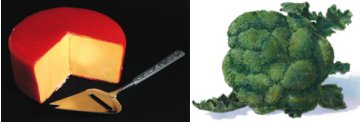Is Vitamin D Fattening?
Forget its name. Vitamin D isn’t a vitamin, but rather the raw ingredient from which the body fashions one of its most important hormones. And in the past 5 years, dozens of studies have illustrated the power of that hormone to not only build bone but also fight a host of important diseases—from cancer and age-related muscle wasting to diabetes and multiple sclerosis (SN: 10/9/04, p. 232: Vitamin Boost).



But one of the newest identified functions of the hormonal form of vitamin D, known as 1,25-D, is its role in determining how the body manages energy. In the American Journal of Clinical Nutrition, this past May, Michael B. Zemel laid out how 1,25-D helps the body decide whether the calories a person eats will be burned or stored as fat.
Earlier, his team at the University of Tennessee showed that calcium-rich products, especially milk and other dairy goods, foster weight loss (SN: 4/29/00, p. 277: Calcium may become a dieter’s best friend). While investigating the mechanism behind this phenomenon, the Tennessee researchers discovered that fat cells contain receptors for 1,25-D. Furthermore, they found, the hormone actually promotes weight gain by sending calories into storage.
Zemel emphasizes that “it’s not the dietary vitamin D that does this” but its hormonal form. “Moreover, there’s no one-to-one relationship between that dietary vitamin D and how much 1,25-D you have,” he adds. “That will be determined by your [body’s] calcium status.”
One way that calcium appears to foster weight reduction, the scientists report in the September FASEB Journal, is by inhibiting the production of 1,25-D.
When calcium concentrations in the body are low, the parathyroid gland in a person’s neck senses it and secretes parathyroid hormone, which has a host of activities. One of them is to turn on the production of 1,25-D in the kidneys. So, to keep that hormone at low to moderate concentrations, people must maintain adequate calcium intake, Zemel says.
How adequate? Data from a range of studies now suggest that some 1,200 milligrams per day would be ideal, he says. That’s slightly more than the daily calcium intake recommended by the Institute of Medicine for people 14 to 50 years old.
An obsolete adaptation?
In humanity’s distant past, when access to food was uncertain, vitamin D’s regulation of energy metabolism could have been a survival strategy. In a sense, Zemel notes, “calcium was sort of a marker for calories,” because hunter-gatherer societies tended to “eat a fairly calcium-rich diet—albeit that calcium often came in the form of insects, grubs, fish, and small rodents eaten with bones intact.”
As a result, he says, calcium would have signaled when the body had encountered a relative feast and it was safe to use the calories for growth and maintenance of high-energy activities. A plummeting of dietary calcium inputs, by contrast, might indicate the start of a famine and suggest it’s time to conserve resources. Then, all spare calories would be stored as fat, to later be drawn down should starvation threaten.
Such a system would have made good evolutionary sense when most people cycled perpetually and unpredictably between feast and famine, Zemel says. He notes that today, however, when food supplies are stable and abundant in much of the world—and therefore there’s been a decoupling of calcium supplies and calories—this system may actually foster obesity.
That scenario suggests that there are two reasons for people to make sure that they get adequate calcium and vitamin D, Zemel says. First, the vitamin D helps the body absorb calcium efficiently. Second, adequate calcium ensures that the parathyroid gland won’t trigger a fat-inducing 1,25-D buildup.
A faster route to fat
The Tennessee researchers have been investigating the genetics of vitamin D’s complex action on energy metabolism. It starts when 1,25-D opens a channel in the outer membrane of fat cells, allowing calcium to pour in. This does two things, Zemel has found.
In the nucleus of these cells, the calcium flood turns on a gene called fas, for fatty-acid synthase, which triggers the production of a key enzyme responsible for making more body fat out of simple sugars. In addition, Zemel finds, the intracellular calcium inhibits the biochemical machinery responsible for both the breakdown of fat cells and fat burning.
“Putting all of these elements together,” he says, “you find that when you don’t have enough calcium in your diet . . . the end result can be bigger, fatter fat cells.”
Moreover, 1,25-D inhibits the activation of a gene called UCP-2 (for uncoupling protein 2). Explains Zemel, the protein this gene makes “was originally discovered as one that . . . makes us less efficient at using our energy.” In dieters, it means that cells burn fewer calories and store more of them as fat.
The Tennessee researchers have investigated how this happens. One thing that the protein from an expressed UCP-2 gene normally does is regulate the orderly death of fat cells. It targets them for disposal by the body’s housekeeping cells, a process that also carries away any fat the cells may have been holding. However, Zemel told Science News Online, “when you suppress UCP-2 with a low-calcium diet or increases in 1,25-D, your body won’t be able to do as good a job at killing off your big old fat cells.” On the other hand, boosting the diet’s calcium content will suppress the 1,25-D in fat cells, he points out, “which will allow UCP-2 expression to proceed normally . . . and help you kill off those big old fat cells, again.”
Although any calcium source will do—even supplement pills—Zemel’s team has shown in a series of studies that “dairy products are more effective than plain calcium” at suppressing 1,25-D concentrations in fat cells. It turns out, he says, that “there are other components in dairy [foods] that act synergistically with the calcium to inhibit fat synthesis and augment fat breakdown.” One essential amino acid that appears to play an important role is leucine, he says. It’s an agent his team will be focusing on in future studies.







